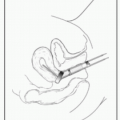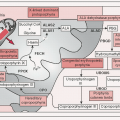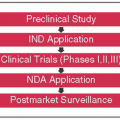Angela G. Michael
Cytarabine (ara-C, Cytosar-U)
Dosing/dose adjustments: Standard dose: 100-200 mg/m
2/
d 24
h CIVI × 5-7
d.
High dose: 1500-3000 mg/m
2 IV q12h × 3
d. No renal or hepatic dose adjustments recommended (use w/caution).
PK/PD: Wide & rapid distribution, crosses
BBB (
conc. 40-50% plasma), hepatic metabolism, eliminated via deamination in liver, plasma, & peripheral tissue, T1/2 1-3
h
Adverse effects: Myelosuppression (DLT, black box warning (BBW), nadir biphasic 7-9 d/15-24 d), N/V (low-to-mod. emetogenic potential), diarrhea,
GI ulceration, ↑
LFTs, neurotoxicity (cerebellar dysfunction, reversible, high dose), rash, conjunctivitis (high dose)
Drug-drug interactions (DDI): Cyclophosphamide (fatal
CMP, case reports),
MTX (↑ formation of
ara-CTP), fludarabine (↑ formation of
ara-CTP), gentamicin (potential ↓ efficacy of gentamicin), digoxin (↓ absorption of digoxin)
Clinical pearls: Can be administered as
IT Rx.
Ppx corticosteroid (0.1% dexamethasone 1-2 gtt every 6
h during & 2-7
d after) w/high dose.
Gemcitabine (Gemzar)
Dosing/dose adjustments: Pancreatic CA: 1000 mg/m
2 IV weekly × 7 wks, w/1
wk rest;
NSCLC: 1000 mg/m
2 IV d 1, 8, 15 every 28
d;
breast CA: 1250 mg/m
2 IV d 1, 8 every 21
d (w/paclitaxel)
OR 800 mg/m
2 IV d 1, 8, 15 every 28
d;
Ovarian CA: 1000 mg/m
2 IV d 1, 8 every 21
d. No renal or hepatic dose adjustments recommended.
PK/PD: Intracellular metabolism by nucleoside kinases, renal excretion (92-98%), T1/2 metabolite 1.7-19.4
h
Adverse effects: Myelosuppression (DLT, ↑ w/infusional), edema, flu-like syndrome, ↑
LFTs, ↑ Tbili, pneumonitis, infusion
rxn, proteinuria,
N/V (low emetogenic potential),
TTP/
HUS (rare)
DDI: Cisplatin (↓ clearance of gemcitabine)
Clinical pearls: Irritant, radiation sensitizer (caution w/thoracic
RT)
Azacytidine (5-Azacytidine, Vidaza)
Dosing/dose adjustments: 75 mg/m
2/
d SQ/
IV × 7d every 4 wks, ↑ dose to 100 mg/m
2/
d if no response after 2 cycles. Caution in pts w/renal & hepatic dysfunction. Adjust dose for
tox (hematologic, ↑
BUN/
Cr).
PK/PD: Does not cross
BBB, hepatic metabolism via hydrolysis, bioavailability SQ ˜89%, renal excretion (50-85%), T1/2 ˜4
h
Adverse effects: Myelosuppression,
N/V (
mod. emetogenic potential), pyrexia,
HA, dizziness, ↑
LFTs, rigors, arthralgia
DDI: No significant drug interactions
Clinical pearls: Use w/caution in pts w/altered mental status
Decitabine (Dacogen)
Dosing/dose adjustments: 15 mg/m
2 every 8
h × 3
d every 6 wks
OR 20 mg/m
2 daily × 5
d every 28
d. No renal or hepatic dose adjustments recommended. Hold/adjust dose for
tox (hematologic, serum creatinine (
SCr) ≥2 mg/dL,
ALT, TBili ≥2 ×
ULN, active or uncontrolled
infxn).
PK/PD: Metabolism via deamination, T1/2 ˜30-35
min
Adverse effects: Myelosuppression (up to 90%, recovery 28-50
d), nausea (40-42%), diarrhea (28-34%), pyrexia (up to 53%),
HA (23-38%), insomnia, fatigue, petechiae (12-39%), ↑ glu, ↑ Tbili, ↓ Mg, ↓ K
DDI: No significant drug interactions
Methotrexate (MTX, Trexall)
Dosing/dose adjustments: Dosing dependent on malignancy, range 30-40 mg/m
2/
wk to 100-12000 mg/m
2 IV once.
CrCl 10-50 mL/
min: 50% of dose;
CrCl <10 mL/
min: Avoid;
HD: 50% of dose. TBili 3.1-5 mg/dL or
LFTs >3×
ULN: 75% of dose; TBili >5 mg/dL: Avoid.
PK/PD: Extensive distribution into third-space fluids (effusions, ascites, ↑ T1/2), renal excretion (80-90% as unchanged drug)
Adverse effects: Myelosuppression, mucositis,
N/V, nephrotoxicity (intratubular precipitation, direct tubular toxin), ↑
LFTs, ↑ Tbili, neurotoxicity
DDI: Probenecid,
PCN,
ceph.,
ASA, NSAIDs, sulfonamides (↓ excretion of
MTX), asparaginase (↓
MTX activity), leucovorin (↓
MTX activity)
Clinical pearls: Vigorous hydration & urinary alkalinization should be implemented during
Rx (↓ incidence of renal failure), requires administration of leucovorin rescue (doses >500 mg/m
2)
Pemetrexed (Alimta)
Dosing/dose adjustments: 500 mg/m
2 d 1 every 21
d. Renal:
CrCl < 45 mL/
min: Avoid.
Concomitant NSAID: CrCl 45-79 mL/
min &
NSAID w/short T1/2 (ibuprofen, indomethacin, ketoprofen, ketorolac): Avoid
NSAID 2
d prior,
d of & 2
d post-Rx; Any
CrCl &
NSAID w/long T1/2 (nabumetone, naproxen, oxaprozin, piroxicam): Avoid
NSAID 5
d prior,
d of & 2
d post-Rx. Hepatic: Grade 3-4 ↑
LFTs: 75% of dose. Adjust dose for
tox (hematologic, mucositis, diarrhea, neurotoxicity).
PK/PD: Renal excretion, T1/2 3.5
h (↑ 5.3-5.8
h CrCl 40-59 mL/
min)
Adverse effects: Myelosuppression (DLT), mucositis, hand-foot syndrome, anorexia, fatigue,
GI tox, ↑
LFTs
Clinical pearls: Folic acid 400-1000 µg daily (7
d prior, during
Rx & 21
d after last dose), cyanocobalamin 1000 µg IM (7
d prior, every 3 cycles) to prevent
GI tox. Dexamethasone 4 mg
PO twice daily (start
d prior to
Rx × 3
d) for
prev of cutaneous rxns.
Pralatrexate (Folotyn)
Dosing/dose adjustments: 30 mg/m
2 IV weekly × 6 wks, 1
wk rest. Use caution in renal impairment. TBili > 1.5 mg/dL or
AST/
ALT > 2.5 ×
ULN: Omitted in trials, use w/caution. Grade 3 hepatotoxicity (on
tx): Hold, ↓ to 20 mg/m
2; grade 4 hepatotoxicity (on
tx): D/C. Adjust dose for
tox (hematologic, mucositis)
PK/PD: 67% protein bound, renal excretion (35%), T1/2 12-18
h
Adverse effects: Mucositis (DLT), myelosuppression (DLT), ↑
LFTs, anorexia, fatigue, edema, rash, ↓ K, nausea, cough, epistaxis, night sweats
DDI: Probenecid,
PCN,
ceph., aspirin, NSAIDs (↓ renal excretion)
Clinical pearls: Folic acid 1-1.25 mg/
d (10
d prior, during
Rx & 30
d after last dose), cyanocobalamin 1000 µg IM (
w/in 10
wk prior, every 8-10 wks) to prevent
GI tox
Cladribine (Leustatin)
Dosing/dose adjustments: 0.09 mg/kg/
d IVCI × 7d. Renal:
CrCl 10-50 mL/
min: 75% of dose;
CrCl < 10 mL/
min: 50% of dose;
CAPD: 50% of dose. Caution in pts w/hepatic dysfunction.
PK/PD: Bioavailability ˜50%, penetrates
CSF (
conc. ˜25% plasma), renal excretion, T1/2 5.4
h
Adverse effects: Myelosuppression (BBW, dose-dependent, prolonged), neurotoxicity (BBW, dose-related, doses above FDA recs, including paraparesis), renal tox (BBW, dose-related, doses above FDA recs), HA, dizziness, fever (33-69%), fatigue (11-45%), prolonged lymphopenia
DDI: Live vaccines (vaccinial
infxn may occur)
Clofarabine (Clolar)
Dosing/dose adjustments: ALL (≤21 y): 52 mg/m
2/
d × 5
d every 2-6 wks;
AML (induction): 30 mg/m
2/
d × 5d;
AML (consolidation): 20 mg/m
2/
d × 5d. Use w/caution in renal & hepatic impairment.
PK/PD: Intracellular metabolism to active metabolite, renal excretion, T1/2 5
h in children, 7
h in adults, ↑ in elderly/renal impairment
Adverse effects: Myelosuppression (DLT), N/V (
mod. emetogenic potential), diarrhea,
SIRS, ↑ opportunistic
infxn, renal
tox, ↑
LFTs/Tbili (w/i 10
d, duration ≤15
d), cardiac
tox
DDI: Warfarin (↑/↓ warfarin effects), nephrotoxins (cum. nephrotoxicity)
Clinical pearls: Consider ppx corticosteroids (hydrocortisone 100 mg/m
2 d 1-3,
prev of capillary leak/
SIRS)
Fludarabine (Fludara)
Dosing/dose adjustments: 20-30 mg/m
2 IV × 3-5
d every 28
d (dosing varies based on malignancy)
OR 40 mg/m
2 PO d 1-5 every 28
d.
CrCl 50-79 mL/
min: ↓ dose to 20 mg/m
2;
CrCl 30-49 mL/
min: ↓ dose to 15 mg/m
2;
CrCl < 30 mL/
min: Avoid use. No hepatic dose adjustments recommended.
PK/PD: Extensive tissue distribution, dephosphorylated in plasma → active metabolite → phosphorylated in cells, renal excretion (60%), T1/2 ˜20
h
Adverse effects: Myelosuppression (DLT, BBW, nadir 10-14 d, recovery 5-7 wks), immunosuppression,
N/V (low emetogenic potential), fever (60-69%), fatigue, diarrhea, weakness, cough (10-44%),
PNA,
infxn (33-44%),
AIHA
DDI: Pentostatin (fatal pulm tox, BBW), Imatinib (↓ fludarabine effects), live vaccines (vaccinial
infxn may occur)
Clinical pearls: Recommend antiviral & antipneumocystis ppx w/use
Nelarabine (Arranon)
Dosing/dose adjustments: 1500 mg/m
2/dose
d 1, 3, 5 every 21
d until transplant, progression or unacceptable
tox. Use caution in
CrCl < 50 mL/
min (↓ ARA-G clearance). Closely monitor w/mod.-sev. hepatic impairment (Tbili > 3 ×
ULN). Consider delay or D/C for
tox (neurotoxicity, hematologic).
PK/PD: Hepatic metabolism (ARA-G), T1/2 ˜2-3
h (metabolite)
Adverse effects: Myelosuppression,
neurotoxicity (DLT, BBW, somnolence, HA, seizures, fatigue, hypoesthesia, D/C if ≥grade 2), ↑
LFTs, ↑ Tbili, ↑ K, myalgia, arthralgia, cough, dyspnea, blurred vision
DDI: Pentostatin (↓
conc. of nelarabine), live vaccines (vaccinial
infxn may occur)
Pentostatin (Nipent)
Dosing/dose adjustments: 4 mg/m
2 every 2 wks. Use w/caution in pts
w/CrCl <60 mL/
min. No hepatic dose adjustments recommended.
Adverse effects: Myelosuppression (nadir 7
d),
CNS tox (BBW, higher than rec. dose), hepatotoxicity (BBW, higher than rec. dose), pulm tox (BBW, higher than rec. dose), nephrotoxicity (BBW, higher than rec. dose), fever, fatigue,
HA, rash, ↑
LFTs, myalgia, cough,
infxn
DDI: Fludarabine (fatal pulm
tox), carmustine, etoposide, high-dose cyclophosphamide (fatal pulm edema &
HoTN)
Capecitabine (Xeloda)
Dosing/dose adjustments: 1000-1250 mg/m
2 PO twice daily × 2 wks every 21
d. Renal:
CrCl 30-50 mL/
min: 75% of dose;
CrCl < 30 mL/
min: Use contraindicated. Caution in hepatic dysfunction. Adjust dose for
tox (hematologic) w/docetaxel or ixabepilone.
PK/PD: Bioavailability ˜ 80%, protein binding < 60%, hepatic & tissue metabolism (active metabolite:
5-FU), renal excretion (96%), T1/2 0.5-1
h
Adverse effects: Diarrhea, hand-foot syndrome, myelosuppression, mucositis, neurologic
tox, coronary vasospasm
DDI: Oral anticoagulants (↑ levels of anticoagulants), phenytoin (↑ levels of phenytoin), leucovorin (↑
tox of capecitabine)
Clinical pearls: Oral prodrug of
5-FU, converted via three-step activation process. Available as 150 mg & 500 mg tablets. Take
w/in 30
min after a meal,
DPD deficiency (prolonged clearance, ↑
tox), radiation sensitizer
Fluorouracil (5-FU, Adrucil)
Dosing/dose adjustments: Intravenous push (
IVP): 325-425 mg/m
2/
d × 5
d every 28
d OR 500 mg/m
2/
wk × 6 wks; IVCI: 750-1000 mg/m
2/
d × 5
d every 21-28
d OR 1200 mg/m
2/
d × 2
d. Use w/caution in pts w/renal impairment & avoid use w/Tbili >5 mg/dL.
PK/PD: Extensive tissue distribution, saturable catabolism, excretion via metabolism, lung, & urine, T1/2 8-14
min after bolus
Adverse effects: Diarrhea (DLT), mucositis (DLT), N/V (low emetogenic potential), myelosuppression (bolus > IVCI), neurotoxicity, coronary artery vasospasm, conjunctivitis, hand-foot syndrome (IVCI > bolus), alopecia, nail changes
DDI: CYP2C9 substrates (↓ substrate levels), oxaliplatin (↓
TS), cimetidine (↓ clearance of
5-FU), oral anticoagulants (↑ levels of anticoagulants), leucovorin (↑
tox of
5-FU)
Clinical pearls: DPD deficiency (prolonged clearance, ↑
tox), predictors of ↑
tox (↑ age, female, poor
PS), radiation sensitizer
Mercaptopurine (6-MP, Purinethol)
Dosing/dose adjustments: 1.5-2.5 mg/kg/
d oral (duration dependent on malignancy).
CrCl < 50 mL/
min: Every 48
h. No hepatic dose adjustments recommended.
PK/PD: Erratic
PO absorption, oxidized via
xanthine oxidase
Adverse effects: Myelosuppression,
GI tox (
N/V, anorexia, diarrhea, stomatitis), cholestatic jaundice, ↑ risk of
infxn
DDI: Allopurinol (↑ mercaptopurine tox, reduce dose by 50-75%)
Clinical pearls: TPMT deficiency (reduce dose to 5-25% of standard dose)
Thioguanine (6-TG, Tabloid)
Dosing/dose adjustments: 60 mg/m
2/
d × 14d. No renal dose adjustments recommended. Hepatotoxicity (on
tx, including
VOD): D/C.
PK/PD: Erratic
PO absorption, hepatic metabolism via TPMT, T1/2 5-9
h
Adverse effects: Myelosuppression,
GI tox (
N/V, anorexia, diarrhea, stomatitis), cholestatic jaundice, ↑ risk of
infxn,
2° malignancy
DDI: No significant drug interactions
Clinical pearls: TPMT deficiency (reduce dose to 5-25% of standard dose)
Hydroxyurea (Droxia, Hydrea)
Dosing/dose adjustments: 20-30 mg/kg oral daily (
CML, solid tumors)
OR 50-100 mg/kg until
WBC <100 K. Titrate dosing for
WBC &
plt count.
CrCl 10-50 mL/
min: 50% of dose;
CrCl < 10 mL/
min: 20% of dose;
HD: Administer dose after
HD on
HD d. No hepatic dose adjustments recommended. Adjust dose for
tox (rash,
GI, mucositis, hematologic).
PK/PD: Readily absorbed, widely distributed including
CSF, 75-80% protein bound, metabolism via hepatic &
GI tract, renal excretion, T½ ˜2-4
h
Adverse effects: Myelosuppression (DLT, primarily granulocytopenia w/in 2-5 d), GI ulceration, skin pigmentation, rash, squamous carcinoma (skin)
DDI: Didanosine, Stavudine (↑/↓
conc. of hydroxyurea, fatal pancreatitis), radiation (↑ tissue Sn to radiation)
Clinical pearls: Available as 200 mg, 300 mg, 400 mg, & 500 mg capsules
Info. based on publicly available drug inserts from Allos, Bedford, Berlex, Bristol Meyers-Squibb, Celgene, Centocor Ortho-Biotech, Eisai, Genzyme, GlaxoSmithKline, Hoffman-LaRoche, Hospira, Lilly, and Teva.









